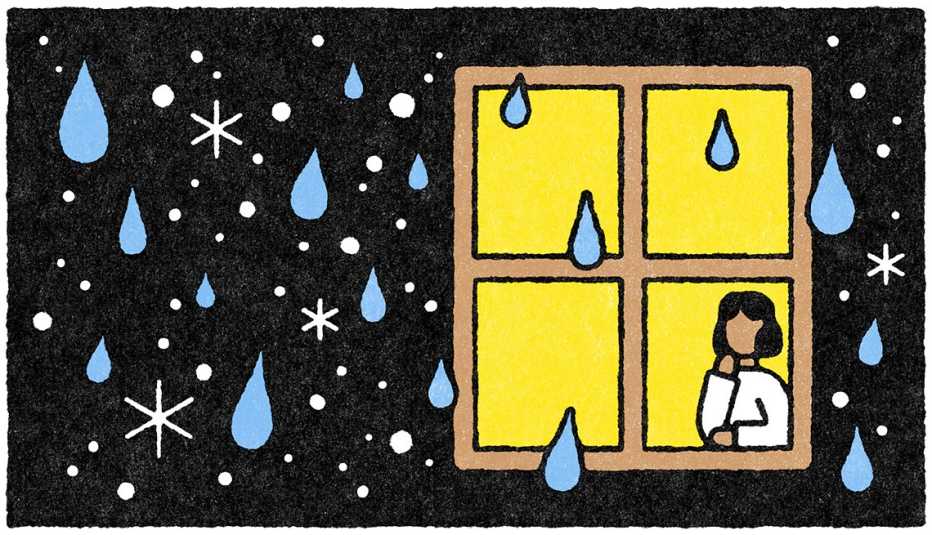AARP Hearing Center


If winter makes you feel blah instead of blissful, you’re not alone: About five percent of U.S. adults, or some 13 million, experience seasonal affective disorder (SAD), according to the American Psychiatric Association. To help combat the winter blues, we’ve curated 25 tips to try, and we want to hear yours as well. Share your seasonal pick-me-ups in the comments section at the bottom of the page.
Note: Anyone experiencing symptoms of depression should consult a physician.
1. Make your home happier
Winter is for nesting, and you probably spend a lot more time indoors than you do when it’s warm outside. If you love your home, you’ll relish that time; if you loathe your home, you’ll resent it. Fortunately, making just a few simple tweaks to your space can make it feel more like a sanctuary than a prison. “Bring in more natural light by using sheer curtains or light-filtering window shades that allow daylight to fill your home,” says interior designer Vivianne Chow, owner of Viv & Tim Home. “You can easily switch out throw pillows or artwork to incorporate brighter colors like yellow or orange that help to lift your mood. Bringing in soft throw blankets or plush rugs can make any space feel cozy and inviting.” If you don’t already have one, now’s the perfect time to create a cozy corner in which to relax when you need a timeout. “A reading nook with a comfy chair and good lighting, or a meditation spot with soft cushioning, can be personal retreats,” says interior designer Artem Kropovinsky, founder of New York-based interior design studio Arsight.
2. Wax nostalgic
While you’re redecorating, consider infusing your home with nostalgic artifacts and mementos — for example, treasured family photos, movie posters of your favorite films, album covers from your favorite artists, books by your favorite authors or heirlooms that remind you of your childhood. Research from a Japanese study published in 2016 in Social Cognitive and Affective Neurosciences shows that nostalgic experiences activate not only the areas of the brain that are associated with memory but also those that are associated with pleasure and rewards. A happy memory could be exactly the kind of pick-me-up you need on a dreary winter’s day. And if you have time for more than a quick hit, go one step further by actually flipping through your photo albums, rereading that favorite book or rewatching that favorite film.
3. Find your community
People often hibernate in winter — hunkering down at home and trading happy hours and barbecues for blankets and binge-watching. Often, the consequence is loneliness, and connection is the cure, suggests physician Jeremy Nobel, founder and president of The Foundation for Art & Healing and author of Project UnLonely: Healing Our Crisis of Disconnection. The best way to make new friends, he says, is to nurture your most passionate interests — be it classic cars, gluten-free cooking, basket-weaving or bird-watching. “Find something you really care about,” urges Nobel, who says camaraderie awaits in both online and offline forums. He recalls one woman, for example, who tapped into an online community of wildlife enthusiasts who watch live video streams of bears in national parks. “She was going through a health issue, and when she happened to mention that in a chat, she found that people expressed unbelievable support for her. … When we’re really interested in something, we feel a kind of connection to other people who are also interested in that. But it only works if it’s something you’re truly curious about.”
4. Boost your mood with music
One form of art that’s particularly potent is music, says Mark Atkinson, a medical doctor and head of human potential development at Sens.ai, a tech startup specializing in neurofeedback and personalized brain-training solutions. “Music … promotes brain plasticity,” Atkinson says. “The key is to avoid thinking about the music, but instead to allow the energy and information of the music to flow through you and fill you. Become a conduit for the music. If that music has a positive association … it will trigger a cocktail of hormones.” It doesn’t matter if it’s Beethoven, Bon Jovi or the Beatles. What matters is that it fills you with comfort or joy. “My recommendations are to have a playlist of music that you really enjoy, and to listen to music for at least 10 minutes a day … in an environment that allows you to melt into the music for maximal effect.”
5. Let there be light
Although too much exposure can increase your risk for skin cancer and eye disease, studies show that moderate amounts of sunlight are extremely beneficial. The sun’s ultraviolet rays help your body produce vitamin D, for example, which is crucial for bone health, muscle function and immunity. They also regulate your body’s circadian rhythms, which can impact your sleep quality. They even affect hormone production, which can impact your mood. Unfortunately, shorter days and colder weather mean that many people don’t get adequate sun exposure in wintertime. If you’re among them, you might want to invest in a light box, suggests clinical psychologist Joe Trunzo, professor of psychology at Bryant University. “Light boxes emit artificial UVB rays, which can be a useful way to get sunlight on days with cloud cover,” explains Trunzo, who says there are consumer-grade devices available without a prescription. “A study out of Yale showed that the best light boxes emitted 10,000 lux at a distance greater than 11 inches. Lower lux numbers, or 10,000-lux light boxes that call for distances closer than 11 inches, are still effective, but will require more time to get the requisite light.”


6. Dance it out
While you’re listening to your favorite music, you might as well dance to it, too. “Dance by yourself or — even better — with a partner, friend or family member. It’s … an instant mood shifter,” say Susan Magsamen, co-author, along with Ivy Ross, of Your Brain on Art: How the Arts Transform Us. Indeed, a 2021 survey of 1,000 people by UCLA Health found that 98 percent of people who practice “ecstatic dance” — free-moving, unchoreographed movement — experience improved mood. Plus, what’s good for your mind is good for your body. “Winter can activate chronic aches and pains that bring us down,” Magsamen notes. “This can be managed by dancing and moving — even using virtual reality.”
7. Feel the vibrations
Music isn’t the only soundtrack that can turn your winter frown upside-down. “Put in your earbuds and listen to the sounds of the ocean, rain, wind, chimes or even singing bowls,” Magsamen suggests. “These recordings can be easily found online. Sound is an excellent tool to help regulate stress, in that it can work on an unconscious level. The frequency of sound instantly taps into what lies underneath conscious recognition, literally changing the vibrations in your body.” To find sound files to listen to, search on YouTube, Spotify, or calmsound.com.
8. Practice the art of ‘inner smiling’
How you feel starts with how you think, according to Atkinson, who says you can make your body feel safe and relaxed by engaging in the practice of “inner smiling.” “Close your eyes and allow your face and eyes to start smiling, even if you don't feel like smiling,” Atkinson advises. “Allow that smile to expand into your whole body. Notice how the process of thinking closes down the smile. Be centered in your heart, no effort, simply smiling. With practice, you can feel an expansive sense of warmth and well-being within just a few seconds. It's a powerful and direct way to elevate your mood and shift your state.”





































































You Might Also Like
Create a Home Gym
From what flooring is best to which equipment to buy and how to optimize your space, we have tips to exercise at home
Top Tips for Finding Happiness
What foods to eat, embracing bright colors and more, our gladness gurus have strategies that may boost your mood
Smart Guide to Healthy Habits
Recommended for You